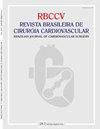冠状动脉搭桥术后颈动脉狭窄的治疗策略比较
IF 1.2
4区 医学
Q4 CARDIAC & CARDIOVASCULAR SYSTEMS
Revista Brasileira De Cirurgia Cardiovascular
Pub Date : 2022-05-23
DOI:10.21470/1678-9741-2020-0425
引用次数: 0
摘要
引言在接受冠状动脉搭桥术(CABG)的患者中,中风是增加发病率和死亡率的主要并发症。颈动脉狭窄(CS)的存在增加了中风的风险,由于缺乏随机临床试验,最佳治疗方法仍不确定。本研究的目的是比较冠状动脉旁路移植术患者CS的三种治疗方法。方法从2005年到2015年,对79例连续接受冠状动脉旁路移植术的CS患者进行回顾性评价。根据CS治疗,患者被分为三组:17例接受了分期颈动脉内膜切除术(CEA)-冠状动脉旁路移植术,26例接受了同步CEA-CABG,36例在没有颈动脉干预的情况下接受了单独的冠状动脉旁路植入术。主要结果包括术后30天的急性心肌梗死(MI)、术后30天脑卒中以及随访期间各种原因导致的死亡。结果患者平均随访2.05年(95%置信区间=1.51~2.60)。主要心脏不良事件,包括死亡、术后心肌梗死和术后卒中,分别发生在分期组的76.5%、同步组的34.6%和隔离CABG组的33.3%(P=0.007)。心肌梗死的发生率分别为29.4%、3.85%和11.1%(P=0.045)。两组之间的总死亡率(分别为35.3%、30.8%和25.0%;P=0.072)和中风(分别为29.4%、7.7%和8.3%;P=0.064)无统计学显著差异。结论与同步和孤立CABG策略相比,分期CEA-CABG与更高的主要不良心脏事件和MI发生率相关,但在整个随访期间总死亡率没有统计学差异。本文章由计算机程序翻译,如有差异,请以英文原文为准。
Comparison Between Treatment Strategies of Carotid Stenosis in Patients Undergoing Coronary Artery Bypass Grafting
Introduction In patients undergoing coronary artery bypass grafting (CABG), stroke is a major complication that increases morbidity and mortality. The presence of carotid stenosis (CS) increases risk of stroke, and the optimal treatment remains uncertain due to the lack of randomized clinical trials. The aim of this study is to compare three management approaches to CS in patients submitted to CABG. Methods From 2005 to 2015, 79 consecutive patients with significant CS submitted to CABG were retrospectively evaluated. Patients were divided in three groups, according to CS treatment: 17 underwent staged carotid endarterectomy (CEA)-CABG, 26 underwent synchronous CEA-CABG, and 36 underwent isolated CABG without carotid intervention. The primary outcomes were composed by 30-day postoperative acute myocardial infarction (MI), 30-day postoperative stroke, and death due to all causes during the follow-up. Results Patients were evaluated during an average 2.05 years (95% confidence interval = 1.51-2.60) of follow-up. Major adverse cardiac events, including death, postoperative MI, and postoperative stroke, occurred in 76.5% of the staged group, 34.6% of the synchronous group, and 33.3% of the isolated CABG group (P=0.007). As for MI, the rates were 29.4%, 3.85%, and 11.1% (P=0.045), respectively. There was no statistically significant difference in total mortality rates (35.3%, 30.8%, and 25.0%, respectively; P=0,72) and stroke (29.4%, 7.7%, and 8.3%, respectively; P=0,064) between groups. Conclusion Staged CEA-CABG is associated with higher major adverse cardiac events and MI rate when compared to the strategy of synchronous and isolated CABG, but without statistically difference in total mortality during the entire follow-up.
求助全文
通过发布文献求助,成功后即可免费获取论文全文。
去求助
来源期刊

Revista Brasileira De Cirurgia Cardiovascular
CARDIAC & CARDIOVASCULAR SYSTEMS-SURGERY
CiteScore
2.10
自引率
0.00%
发文量
176
审稿时长
20 weeks
期刊介绍:
Brazilian Journal of Cardiovascular Surgery (BJCVS) is the official journal of the Brazilian Society of Cardiovascular Surgery (SBCCV). BJCVS is a bimonthly, peer-reviewed scientific journal, with regular circulation since 1986.
BJCVS aims to record the scientific and innovation production in cardiovascular surgery and promote study, improvement and professional updating in the specialty. It has significant impact on cardiovascular surgery practice and related areas.
 求助内容:
求助内容: 应助结果提醒方式:
应助结果提醒方式:


